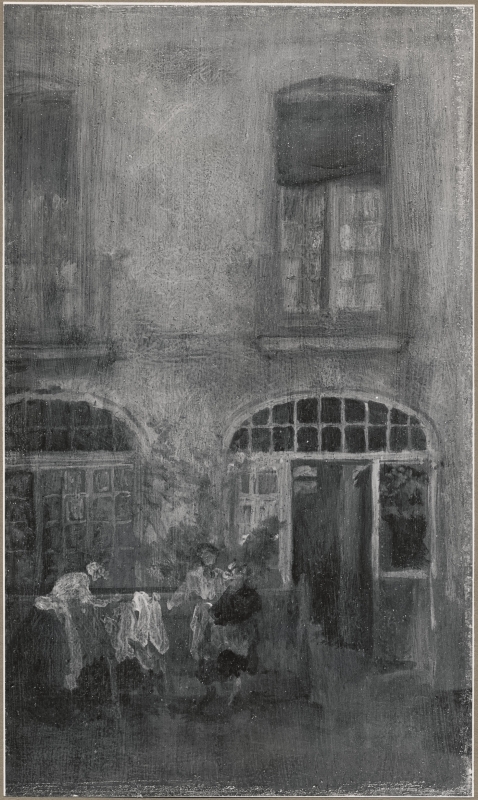Provenance
- 1900: sold by Alexander Reid (1854-1928) , Glasgow art dealer, to John James Cowan (1846-1936) , Edinburgh, in November 1900.
- By 1914: Knoedler & Co., New York art dealers.
- By 1928: sold by the Macbeth Galleries, New York, to Grenville Lindell Winthrop (1864-1943) ;
- 1943: bequeathed by G. L. Winthrop to the Fogg Art Museum.
In 1886 the price was estimated by Messrs Dowdeswell at £30.0.0 but it was finally priced at £35.0.0 by Whistler. 1 For Munich in 1888 the value was given as £40, and by 1889, in New York, 50 guineas, at which price it did not sell. 2 It may be the 'Hotel Diepe' (sic) priced by Whistler at 120 guineas, in 1891, although this seems rather a steep rise in price. 3 And it is also possible that it is the 'Hotel Garden Dieppe' sent by Whistler to Arthur Melville (1855-1905), priced at 100gns, possibly for an exhibition that has not so far been identified. 4
According to Reid's son, Alexander James McNeill Reid (1893-1972), his father sold this painting, which he described as 'The Laundry', to Cowan for £90.0.0 in November 1900. 5 In the following year, Cowan described it to Whistler as 'House front ... woman apparently washing clothes to left outside', and sent a photograph, which Whistler identified as 'Courtyard House in Dieppe'. 6 According to Mortimer Luddington Menpes (1860-1938), who called it mistakenly 'Trouville: Blue and Silver', this was still in Cowan's collection in 1904. 7 It is not known when he sold it, but 10 years later it was exhibited by Knoedler's, New York (cat. no. 9) again as 'Trouville: Blue and Silver' and priced at $4000. 8 G. L. Winthrop bought it, under the same title, 'Trouville: Blue and Silver', through the Macbeth Galleries, at some date, probably before 1928.
Exhibitions
- 1886: 'Notes' - 'Harmonies' - 'Nocturnes', Second Series, Messrs Dowdeswell, London, 1886 (cat. no. 46) as 'White and grey – La cour de l'Hotel, Dieppe'.
- 1888: III. Internationale Kunst-Ausstellung, Königlicher Glaspalast, Munich, 1888 (cat. no. 61) as 'Grau und Silber: Hotel Dieppe'.
- 1889: “Notes” – “Harmonies” – “Nocturnes”, H. Wunderlich & Co., New York, 1889 (cat. no. 30) as 'Grey and Silver – Hotel Yard – Dieppe'.
Although this exhibition and this particular work were rarely mentioned in the press, they received a welcome review in the Globe on 14 May 1886:
'Mr. Whistler has tastefully redecorated Messrs. Dowdeswells' little gallery in New Bond-street in what he calls "an Arrangement in Brown and Gold,” and furnished it with a series of 70 "Notes, Harmonies, and Nocturnes," in oil, water-colour, and pastel. Like those that he exhibited here on a former occasion, they are all very small and very slight. Many of them are mere memoranda of beautiful combinations of colour, with little or no definition of form, but they nearly all show true artistic instinct and rare mastery of tone. In some cases Mr. Whistler has succeeded, with very little apparent labour, in giving a vivid impression of natural effect ... His skill in rapidly recording the aspect of a scene, and his fine sense of colour, are still better shown in the small oil studies, “La Cour de l'Hôtel, Dieppe,” and “Blue and Orange—Sweet Shop," with many slightly indicated figures.'
Similarly, the Illustrated London News on 15 May commented:
'At Messrs. Dowdeswell’s Gallery (133, New Bond-street) there is a somewhat remarkable exhibition of Notes—Harmonies and Nocturnes,” by Mr. J. McN. Whistler, which display all that versatile artist’s merits and faults. The difficulty in estimating such works is to know for certain when Mr. Whistler is in earnest, and when he is simply imposing on the public. For instance, there are here at least half score of works which belong to the former category; among such are the "Sands at Dieppe" (1)," ... "Dieppe" (28), "The Sad Seashore" (43), "La Cour de L'Hôtel" (46), "The Sweet-Shop" (49) ... For such as these we can only express an unfeigned admiration.'
Notes:
1: Annotated catalogue, 'Notes' - 'Harmonies' - 'Nocturnes', Second Series, Messrs Dowdeswell, London, 1886 (cat. no. 46), GUL.
2: Whistler to R. Koegler, [June 1888], GUW #04204; Dieterlen, Wunderlich's, to Whistler, 1 November 1889, GUW #07187.
3: [22 August 1891], GUW #13237.
4: [1/8 May 1887], GUW #13475.
5: Information given by A. J. McN. Reid, GUL.
6: 25-26 February 1901, GUW #00743.
7: Menpes 1904 A [more] , repr. f.p. 94.
8: Marked catalogue, University of Michigan Museum of Art.
Last updated: 21st November 2020 by Margaret





